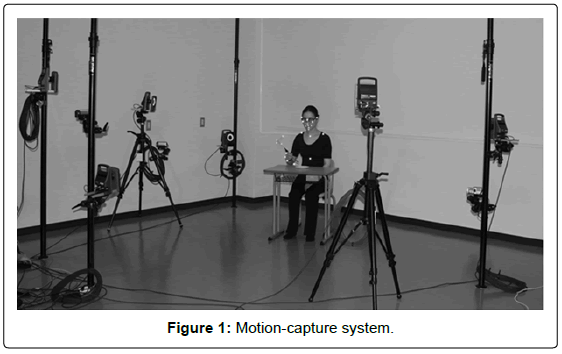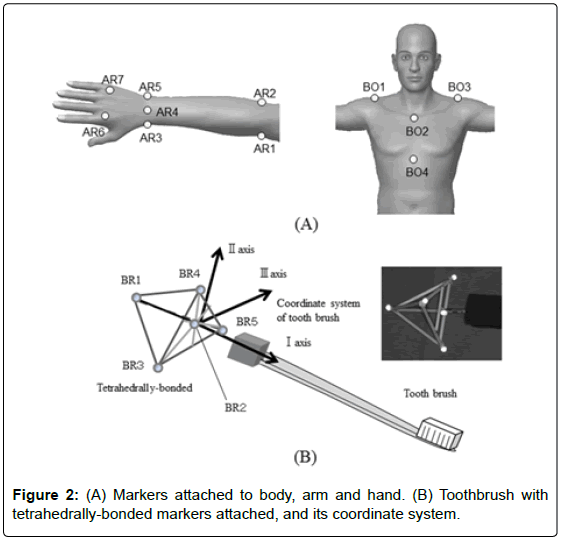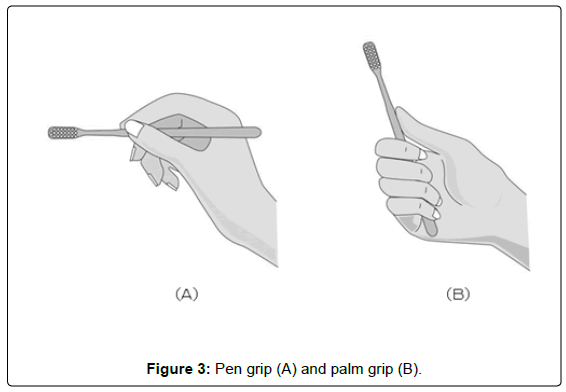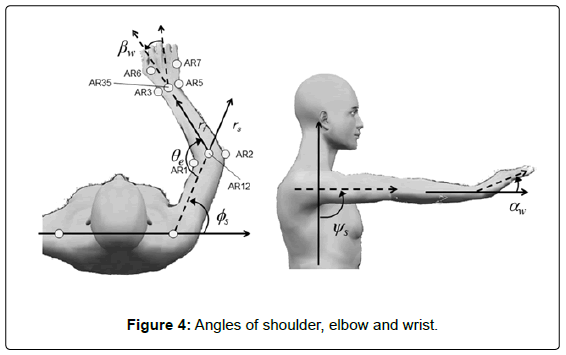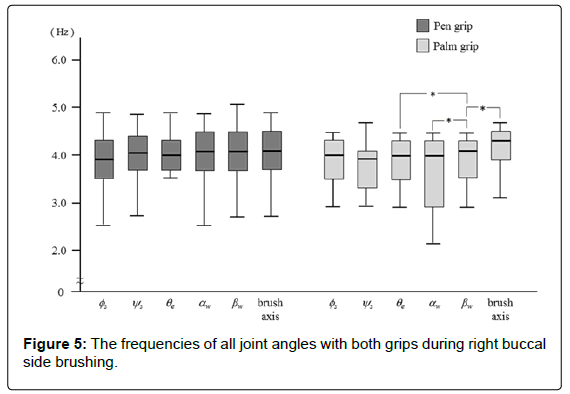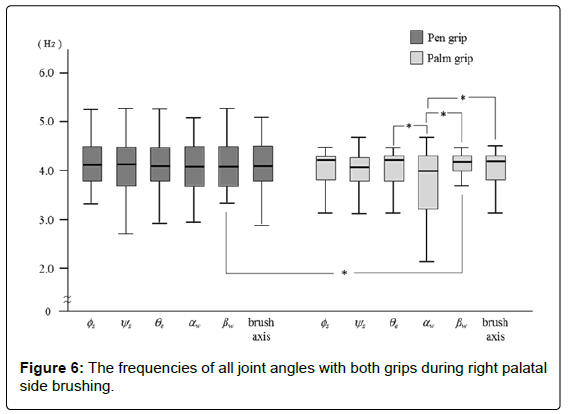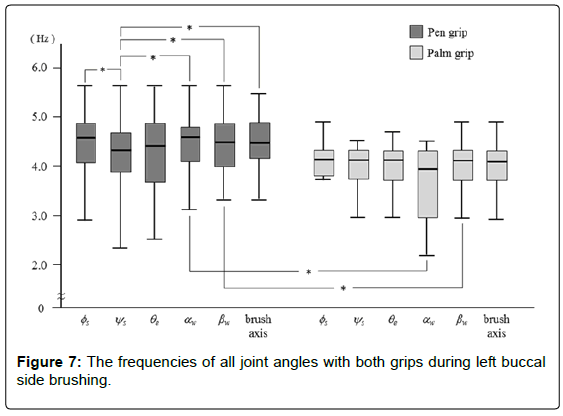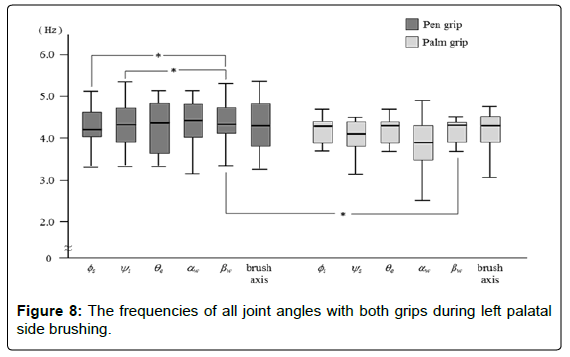Evaluation and Comparison of Arm-Joint and Toothbrush Motion Between Pen Grip and Palm Grip During Tooth Brushing
Received: 02-May-2018 / Accepted Date: 14-May-2018 / Published Date: 23-May-2018 DOI: 10.4172/2332-0702.1000241
Abstract
Objective: We aimed to examine the hypothesis that the two different hand-grip techniques (pen grip and palm grip) affect tooth-brushing motion.
Methods: Eight dental hygienists participated in this study. Their tooth-brushing motion for 15 seconds was captured using a motion-capture system. The buccal and palatal sides of the right and left upper molars using both the pen and palm grips were brushed, and the frequency of joint angles of the shoulder, elbow, and wrist was calculated during tooth-brushing.
Results: Individuals showed smaller intra-individual variations in the peak frequency of the toothbrush and joint angles during the brushing of all sides with both the pen and palm grips. For some arm joints, using the palm grip showed higher intra-individual variations than inter-individual, but the intra-individual variations among all joints using the pen grip were lower in all brushing areas.
Conclusion: A distinct individual tooth-brushing rhythm in the reciprocatory motion was established by each dental hygienist using both the pen and palm grips. The coordinated movements of all joints of subjects using pen grips reflected the stability of the tooth-brushing motion of each arm joint. However, when using the palm grip, it is not necessary to ensure joint stability during tooth-brushing motion. Examination by three-dimensional toothbrushing motion analysis revealed that the reciprocatory performance during tooth-brushing was easier with the palm grip than with the pen grip.
Keywords: Tooth brushing; Arm joint motion; Pen grip; Palm grip; Motion capture system
Introduction
Dental and oral health is essential for maintaining satisfactory food intake and articulation and, therefore makes a huge contribution to quality of life [1]. Furthermore, keeping the oral cavity clean is effective for not only the prevention of tooth decay, periodontal disease or halitosis, but it also contributes to maintaining and promoting general health [2,3]. Tooth-brushing skill is very important, and develops from childhood to adolescence [4,5]. However, objectively assessing patients’ brushing skill is an ongoing challenge for dental professionals.
A plaque disclosing agent is available to assess the effectiveness of plaque removal by tooth-brushing currently [6,7]. Patients are instructed on how to move the toothbrush based on the results of a plaque score. Although a toothbrush monitoring system using an accelerometer and a magnetic sensor has been reported as a method to objectively evaluate tooth-brushing motion, the evaluation was limited to only the motion of the toothbrush itself [8,9]. Since the coordinated arm movement is very important during tooth-brushing motion, we reported the evaluation of toothbrush and arm-joint motion using a motion capture system [10].
Generally, tooth-brushing techniques by both the pen grip and palm grip are typical and recommended for holding a toothbrush. It is considered that the tooth-brushing technique by pen grip can control the exquisite tooth-brushing motion effectively because of the detailed operation by the finger motions [11]. We evaluated that dental hygienists performed the arm motion as well as shoulder, elbow, and wrist movements during tooth-brushing and toothbrush motion by using the pen grip. They had a distinct individual tooth-brushing rhythm and all arm joints moved in a synchronous manner [10].
The palm grip is the commonly used method of gripping the toothbrush [12], and it is thought to maintain a stable brushing motion because the whole palm of the hand is wrapped around the toothbrush making it less likely to be affected by a disturbance [13]. Since we are able to hold the toothbrush more easily with the palm grip, younger children and patients with muscle weakness in their hands or fingers caused by aging or disease are sometimes recommended with the palm grip.
In this study, we calculated the frequency of the toothbrush motion as well as the joint angles of the shoulder, elbow, and wrist by the dental hygienists both the pen and palm grips. We aimed to examine the hypothesis whether the two different hand-grip techniques affect tooth-brushing motion.
Materials and Methods
Human subjects
Eight dental hygienists worked at the Kagoshima University Medical and Dental Hospital (healthy females; average age 31 years old; SD 8 years) participated in this study and were right-handed without pain or dysfunction in the craniomandibular, neck, trunk and limb regions. The dental hygienists’ mean clinical experience in years was 11 years and 7 months. Their common brushing technique was horizontal scrubbing. Four subjects preferred the pen grip, three subjects preferred the palm grip, and one subject preferred both grips according to brushing area as their usual grip types. Written informed consent was obtained from the all subjects in accordance with the tenets of the Declaration of Helsinki prior to their entering the study and approved by the clinical ethics committee of Kagoshima University Hospital (No. 26-112).
Capture system
The Vicon systemⓇ (Inter-Reha Co. Ltd., Tokyo, Japan) was used as an optical 3-D motion analyzer as previously described in Inada et al. [10]. Light-reflective balls were attached to the skin of each subject as markers, and the markers’ motion was tracked with six charge-coupled device (CCD) cameras and visualized on a computer display (Figure 1). The markers’ 3-D coordinates were tabulated at 100 Hz.
Marker configuration
Retro-reflective markers (9 mm in diameter) were attached to 1) the jugular notch of the sternum (BO2), the xiphoid process of the sternum (BO4), and the right and left acromion processes (BO1, BO3) to record upper body motion; and 2) the inner and outer elbow (AR1, AR2) and wrist (AR3, AR5), the back of the wrist (AR4), and the dorsum of the hand (AR6, AR7) of the right arm to record arm motion (Figure 2A). In addition, five retro-reflective markers (3.5 mm in diameter) were tetrahedrally bonded (BR1-BR5) and attached to the toothbrush to record its motion (Figure 2B).
Test procedure
The subjects were seated comfortably in an upright position with back support up to the mid-scapular level without a headrest. Brushing was performed using our own previous protocol (Figure 3) [10]. Brushing was confined to the buccal and palatal sides of the right and left upper molars, and brushing was repeated three times in each area for fifteen seconds each time.
Data preparation
The 3-D coordinates of each marker’s position relative to the floor were recorded at 100 samples/sec. The methods of calculating toothbrush motion and joint angles of the shoulder, elbow and wrist used in this study have been previously described in Inada et al. [10]. A summary of the methods of calculation is as follows:
• Reciprocating motion of the toothbrush at each area (Figure 2B).
• Joint angles of the shoulder (φs, ψs), elbow (θe) and wrist (αw, βw) (Figure 4).
Data analysis and statistics
The degree of toothbrush displacement and the angle of change that occurred during brushing for each joint were converted to a power spectrum by Fourier transformation, and the frequency range containing the most power was selected. The frequency and power spectrum of the toothbrush motion and each joint angles were calculated for each subject during brushing. To compare each grip type and each area, the comparisons of cross-joint and toothbrush motion of the frequency were evaluated using the Friedman test and the Wilcoxon signed-rank test, and statistical significance was set at P
Results
There were no significant differences in the frequency of all joint angles with the pen grip during right buccal and palatal side brushing (Figures 5 and 6). However, the frequencies between the wrist abduction angle (βw) and the wrist flexion angle (aw), elbow flexion angle (θe ) and toothbrush motion had significant differences during right buccal side brushing with the palm grip. Regarding brushing of the right palatal side with the palm grip, there were significant differences in frequencies between the wrist flexion angle (aw) and the wrist abduction angle (βw), as well as elbow flexion angle (θe ) and toothbrush motion, and only the frequencies of the wrist abduction angle (βw) showed a significant difference between both grip types (Figure 6).
Tables 1 and 2 showed inter- and intra-individual variations in frequency and power spectrum of joint angles during right buccal and palatal brushing. Intra-individual variation of the frequencies of all joint angles with the pen grip were smaller than inter-individual variation in both grip types. In contrast, inter-individual variations of the frequencies of the vertical shoulder angle (ψs) and wrist flexion angle (aw) during right buccal side brushing with the palm grip and the frequencies, with exception of wrist flexion angle (aw), during right palatal side brushing with the palm grip were smaller than intraindividual variation. Inter and intra-individual variations of the power spectrum of the elbow flexion angle (θe) were smaller than those of any other joint with both grips for both right buccal and palatal brushing areas. The horizontal shoulder angle (φs) on both the right buccal and palatal sides while brushing with the pen grip, and the wrist abduction angle (βw) on the right buccal and wrist flexion angle (aw) on the right palatal side while brushing with the palm grip showed the largest interand intra-individual variations for each grip.
| Angle | Frequency | Power Spectrum | |||||
|---|---|---|---|---|---|---|---|
| Estimate (SE) | Intra-individual | Inter-individual | Estimate (SE) | Intra-individual | Inter-individual | ||
| Pen | φs | 3.94 (0.15) | 0.07 | 0.18 | 101.84 (25.62) | 6062.55 | 3690.29 |
| ψs | 3.94 (0.16) | 0.08 | 0.2 | 44.35 (10.21) | 416.7 | 786.33 | |
| θe | 3.96 (0.16) | 0.07 | 0.21 | 40.97 (7.00) | 137.09 | 390.69 | |
| αw | 3.99 (0.15) | 0.05 | 0.19 | 120.17 (14.45) | 2707.96 | 891.97 | |
| βw | 3.99 (0.16) | 0.09 | 0.21 | 70.35 (10.31) | 1043.09 | 575.53 | |
| Palm | φs | 3.87 (0.16) | 0.03 | 0.2 | 52.72 (6.92) | 53.78 | 367.6 |
| ψs | 3.41 (0.31) | 0.73 | 0.51 | 76.81 (21.95) | 1356.03 | 3348.71 | |
| θe | 3.86 (0.16) | 0.03 | 0.2 | 52.62 (6.98) | 53.78 | 369.23 | |
| αw | 3.41 (0.23) | 0.66 | 0.25 | 96.67 (19.19) | 2963.79 | 1849.24 | |
| βw | 3.69 (0.24) | 0.3 | 0.33 | 266.34 (57.61) | 18403.9 | 19709.8 | |
Table 1: Inter- and intra-individual variations of the frequencies and the power spectrum of the joint angles during right buccal brushing.
| Angle | Frequency | Power Spectrum | |||||
|---|---|---|---|---|---|---|---|
| Estimate (SE) | Intra-individual | Inter-individual | Estimate (SE) | Intra-individual | Inter-individual | ||
| Pen | φs | 4.21 (0.19) | 0.03 | 0.31 | 104.15 (37.31) | 3278.3 | 11437.4 |
| ψs | 4.18 (0.19) | 0.03 | 0.32 | 58.37 (20.12) | 193.37 | 3578.99 | |
| θe | 4.22 (0.18) | 0.03 | 0.3 | 35.22 (6.70) | 69.67 | 380.51 | |
| αw | 4.21 (0.19) | 0.03 | 0.3 | 112.37 (17.27) | 1476.07 | 2191.27 | |
| βw | 4.24 (0.20) | 0.05 | 0.34 | 54.15 (12.16) | 453.48 | 1180.57 | |
| Palm | φs | 3.97 (0.25) | 0.55 | 0.26 | 101.41 (23.39) | 3980.5 | 2270.73 |
| ψs | 3.35 (0.23) | 0.34 | 0.24 | 107.81 (33.28) | 1190.18 | 7249.66 | |
| θe | 3.97 (0.25) | 0.5 | 0.25 | 102.95 (23.90) | 3345.13 | 2672.22 | |
| αw | 2.92 (0.32) | 0.02 | 0.72 | 298.33 (108.46) | 73037.4 | 53467.9 | |
| βw | 3.85 (0.28) | 0.52 | 0.36 | 75.48 (18.38) | 2697.38 | 1315.05 | |
Table 2: Inter- and intra-individual variations of the frequencies and the power spectrum of the joint angles during right palatal brushing.
The frequencies of all joint angles with the palm grip showed no significant differences in left buccal and palatal side brushing, and the results for right side brushing were the reverse (Figures 7 and 8). However, there were significant differences in frequencies between the vertical shoulder angle (ψs) and the horizontal shoulder angle (φs), wrist flexion angle (aw), wrist abduction angle (βw) and toothbrush motion during left buccal side brushing with the pen grip, and the frequencies of the wrist flexion angle (aw) and wrist abduction angle (βw) showed significant differences between both grip types (Figure 7). Regarding left palatal side brushing with the pen grip, there were significant differences in frequencies between the wrist abduction angle (βw) and the horizontal (φs) and vertical shoulder angles (ψs), and only the frequencies of the wrist abduction angle (βw) showed a significant difference between both grip types (Figure 8).
Tables 3 and 4 showed inter- and intra-individual variations of the frequencies and the power spectrum of the joint angles during left buccal and palatal brushing. Intra-individual variation of the frequencies of all joint angles with the pen grip was smaller than interindividual variation in both grip types, and these results were consistent with right side brushing. In contrast, in both left buccal and palatal side brushing with the palm grip, inter-individual variations in the frequencies of the vertical shoulder angle (ψs), wrist flexion angle (aw), and the wrist abduction angle (βw) were smaller than intra-individual variations. Inter- and intra-individual variations of the power spectrum of the elbow flexion angle (θe ) were smaller than those for any other joint with both grips in both the left buccal and palatal brushing areas, and these results were the same for right-side brushing. The wrist flexion angle (aw) with the pen grip and the wrist abduction angle (βw) with the palm grip for left-buccal brushing showed the largest interand intra-individual variations in each grip. In addition, the horizontal shoulder angle (φs) and wrist flexion angle (aw) with the pen grip, and the vertical shoulder angle (ψs) and wrist abduction angle (βw) with the palm grip for left palatal brushing had large inter- and intra-individual variations in each grip.
| Angle | Frequency | Power Spectrum | |||||
|---|---|---|---|---|---|---|---|
| Estimate (SE) | Intra-individual | Inter-individual | Estimate (SE) | Intra-individual | Inter-individual | ||
| Pen | φs | 4.36 (0.20) | 0.02 | 0.36 | 99.36 (11.90) | 225.68 | 1194.43 |
| ψs | 4.33 (0.21) | 0.02 | 0.33 | 50.91 (11.28) | 172.14 | 1083.68 | |
| θe | 4.36 (0.20) | 0.03 | 0.35 | 45.77 (7.90) | 97.39 | 526.78 | |
| αw | 4.38 (0.19) | 0.02 | 0.32 | 145.35 (21.92) | 2646.2 | 3398.55 | |
| βw | 4.36 (0.18) | 0.08 | 0.27 | 59.76 (10.29) | 1266.9 | 510.57 | |
| Palm | φs | 4.01 (0.18) | 0.02 | 0.24 | 101.41 (23.39) | 3980.49 | 2270.73 |
| ψs | 3.47 (0.25) | 1.19 | 0.08 | 57.46 (12.79) | 467.5 | 1152.25 | |
| θe | 4.01 (0.18) | 0.02 | 0.24 | 50.88 (6.16) | 227.58 | 227.36 | |
| αw | 3.09 (0.19) | 1.47 | 0.01 | 52.25 (7.50) | 284.29 | 355.23 | |
| βw | 3.91 (0.25) | 0.31 | 0.17 | 219.83 (72.46) | 3842.63 | 40716.8 | |
Table 3: Inter- and intra-individual variations of the frequencies and the power spectrum of the joint angles during left buccal brushing.
| Angle | Frequency | Power spectrum | |||||
|---|---|---|---|---|---|---|---|
| Estimate (SE) | Intra-individual | Inter-individual | Estimate (SE) | Intra-individual | Inter-individual | ||
| Pen | φs | 4.33 (0.18) | 0.02 | 0.27 | 116.56 (21.54) | 18493.3 | 3558.8 |
| ψs | 4.36 (0.17) | 0.02 | 0.26 | 56.00 (10.55) | 607.63 | 799.52 | |
| θe | 4.37 (0.18) | 0.03 | 0.28 | 50.67 (10.90) | 357.85 | 949.92 | |
| αw | 4.38 (0.19) | 0.03 | 0.31 | 143.11 (15.28) | 3487.85 | 9370.35 | |
| βw | 4.43 (0.17) | 0.02 | 0.25 | 57.07 (12.50) | 1068.82 | 1051.33 | |
| Palm | φs | 4.10 (0.15) | 0.02 | 0.17 | 67.38 (12.73) | 366.5 | 1173.57 |
| ψs | 3.83 (0.25) | 0.41 | 0.36 | 144.71 (40.84) | 37455.7 | 2857.37 | |
| θe | 4.06 (0.16) | 0.02 | 0.18 | 60.71 (12.68) | 170.14 | 1069.21 | |
| αw | 3.35 (0.26) | 0.95 | 0.22 | 88.29 (25.96) | 4703.79 | 3824.92 | |
| βw | 3.99 (0.16) | 0.23 | 0.13 | 282.33 (70.37) | 15853.7 | 3425.49 | |
Table 4: Inter- and intra-individual variations of the frequencies and the power spectrum of the joint angles during left palatal brushing.
Discussion
Our results showed smaller intra-individual variations of the peak frequency of the toothbrush and joint angles during the brushing of all sides with both grips. This suggested that dental hygienists had established stable personal brushing motions for these tasks. Furthermore, regarding in the power spectrum, inter- and intraindividual variations of the elbow flexion angle (θe ) were smaller than other angles during tooth-brushing in all areas. Smaller inter- and intra- individual variations in the power spectrum meant that the elbow did not make complicated movements for motor control and instead maintains a stable repetitive motion during tooth-brushing.
The stability of motion was maintained by individual characteristic rhythms at various points in the body while walking, hopping and during locomotion [14-16]. Moreover, an individual normal stride and cadence during walking had the highest overall stability [17]. Zehr et al. reported that rhythmic arm motions are largely controlled by central pattern generators during locomotion [18]. The reciprocating motion of toothbrush during brushing is a cyclic frequency motion [19]. Our results indicated that the elbow was able to produce an individual’s rhythm through a stabilizing motion during tooth-brushing regardless of the grip type used.
The peak frequency for both the upper right buccal and palatal teeth using the pen grip or for both the upper left buccal and palatal teeth using the palm grip had no significant differences between each arm joint in tooth-brushing motion. This suggested that the cooperated level of each arm joint might be higher than on the other side. In addition, there were some arm joints for which intra-individual variations were higher than inter-individual variations when using the palm grip, but the intra-individual variations of all joints when using the pen grip were lower and more stable in all brushing areas.
When using the pen grip for writing, Baur et al. reported that the thumb was associated with holding the pen, and index and middle fingers controlled writing pressure (i.e., the pressure with which the index and middle fingers press onto the pen) [20]. Each finger could play various different roles in the tooth-brushing motion as well as in writing [21], since the joints of the wrist and shoulder control the motion and power of the fingers [22-24]. Moreover, the stability of, and cooperation between, each joint may be required for the control of motion and the power of the fingers during tooth brushing, especially when using the pen grip.
On the other hand, the characteristics of the palm grip when grasping laparoscopic instruments were reported in comparison with the finger grip which was the method used to grasp an instrument at one’s fingertips as with the pen grip [25]. As a result of the comparison between both grips, it was reported that the palm grip was more suitable for the continuation and maintenance of the motion with minimal muscle stress for the arm, although the precision of the motion was limited [25]. Considering the cooperated level and motion stability of each arm joint with both grips, the motion stability of each arm joint using the pen grip might reflect the coordinated motion of all joints, however, the stable motion of each arm joint using the palm grip might not require such cooperation as that using the pen grip.
Finally, we need to address the role of the shoulder and wrist during brushing. As previously described, smaller inter- and intra-individual variation of the power spectrum indicate such a stable and monotonous as that of the elbow while brushing. In contrast, high inter- and intraindividual variation of the power spectrum means that the motion of the applicable joint is more complicated. The higher inter- and intraindividual variations in the power spectrum of the wrist during the brushing of all sides when using the palm grip were thought to regulate the careful motion of brushing. Whereas, the shoulder during rightside brushing and the wrist during left-side brushing of both the buccal and palatal sides using the pen grip had higher inter- and intraindividual variations of the power spectrum. It is supposed that when brushing using pen grip, the shoulder on the right side and the wrist on left side might regulate careful motion. Thus, it might be more difficult to acquire the pen grip technique because the regulation of the careful motor control of each arm joint is complicated by which areas are being brushed. Moreover, only brushing on the left palatal side with both the pen and palm grips showed higher inter- and intra-individual variation of the power spectrum for both the wrist and shoulder. This suggests that brushing on the left palatal side is difficult because complicated motor control using the whole arm is necessary.
As a result of the examination of tooth-brushing motion using both the pen and palm grips by three-dimensional motion analysis, our study led us to conclude that using the palm grip was easier than using the pen grip to perform the reciprocate motion of the toothbrush.
Conclusion
Eight engaging dental hygienists as subjects, we investigated the frequencies and power spectra of the toothbrush motion and compared the arm-joint (shoulder, elbow and wrist) during tooth brushing with toothbrush motions of both the pen and the palm grips. The results support the following conclusions:
1. A distinct individual tooth-brushing rhythm in the reciprocatory motion of each dental hygienist was established using both the pen and palm grips.
2) The arm joints moved most synchronously during right side brushing using the pen grip and left side brushing using the palm grip on both the buccal and palatal sides.
3) Motion stability of each arm joint was reflected in the coordinated movement of all joints in subjects using the pen grip. However, coordinated joint movement is not necessary to ensure joint stability during the tooth-brushing motion when using the palm grip.
Acknowledgment
This work was supported by KAKENHI from Japan society for the Promotion of Science (No. 16K11809).
Conflict of Interest
There are no potential conflicts.
References
- Hitchings EJ (2011) The oral health of individuals with haemophilia: a review of the literature. N Z Dent J 107: 4-11.
- Bowden J, Scully C (1989) Dentistry and total oral health. BMJ 298: 186.
- Jahn CA (2004) Good oral health contributes to good total health: the role of the diabetes educator. Diabetes Educ 30: 757-760.
- Ashkenazi-Hoffnung L, Lebenthal Y, Wyatt AW, Ragge NK, Dateki S, et al. (2010) A novel loss-of-function mutation in OTX2 in a patient with anophthalmia and isolated growth hormone deficiency. Hum Genet 127: 721-729.
- Rugg-Gunn AJ, Macgregor ID (1978) A survey of toothbrushing behaviour in children and young adults. J Periodontal Res 13: 382-389.
- Sharma S, Yeluri R, Jain AA, Munshi AK (2012) Effect of toothbrush grip on plaque removal during manual toothbrushing in children. J Oral Sci 54: 183-190.
- Biesbrock AR, Walters PA, Bartizek RD, Goyal CR, Qaqish JG (2008) Plaque removal efficacy of an advanced rotation-oscillation power toothbrush versus a new sonic toothbrush. Am J Dent 21: 185-188.
- Kim KS, Yoon TH, Lee JW, Kim DJ (2009) Interactive toothbrushing education by a smart toothbrush system via 3D visualization. Comput Methods Programs Biomed 96: 125-132.
- Lee KH, Lee JW, Kim KS, Kim DJ, Kim K, et al. (2007) Tooth brushing pattern classification using three-axis accelerometer and magnetic sensor for smart toothbrush. Conf Proc IEEE Eng Med Biol Soc 2007: 4211-4214.
- Inada E, Saitoh I, Yu Y, Tomiyama D, Murakami D, et al. (2015) Quantitative evaluation of toothbrush and arm-joint motion during tooth brushing. Clin Oral Investig 19: 1451-1462.
- Niemi ML, Ainamo J, Etemadzadeh H (1987) The effect of toothbrush grip on gingival abrasion and plaque removal during toothbrushing. J Clin Periodontol 14: 19-21.
- Mentes A, Atukeren J (2002) A study of manual toothbrushing skills in children aged 3 to 11 years. J Clin Pediatr Dent 27: 91-94.
- Das UM, Singhal P (2009) Tooth brushing skills for the children aged 3-11 years. J Indian Soc Pedod Prev Dent 27: 104-107.
- Henmi S, Yonenobu K, Masatomi T, Oda K (2006) A biomechanical study of activities of daily living using neck and upper limbs with an optical three-dimensional motion analysis system. Mod Rheumatol 16: 289-293.
- Kavanagh JJ, Barrett RS, Morrison S (2004) Upper body accelerations during walking in healthy young and elderly men. Gait Posture 20: 291-298.
- Mourey F, Pozzo T, Rouhier-Marcer I, Didier JP (1998) A kinematic comparison between elderly and young subjects standing up from and sitting down in a chair. Age Ageing 27: 137-146.
- Latt MD, Menz HB, Fung VS, Lord SR (2008) Walking speed, cadence and step length are selected to optimize the stability of head and pelvis accelerations. Exp Brain Res 184: 201-209.
- Zehr EP, Duysens J (2004) Regulation of arm and leg movement during human locomotion. Neuroscientist 10: 347-361.
- Tosaka Y, Nakakura-Ohshima K, Murakami N, Ishii R, Saitoh I, et al. (2014) Analysis of tooth brushing cycles. Clin Oral Investig.
- Baur B, Schenk T, Furholzer W, Scheuerecker J, Marquardt C, et al. (2006) Modified pen grip in the treatment of Writer's Cramp. Hum Mov Sci 25: 464-473.
- Udo H, Otani T, Udo A, Yoshinaga F (2000) An electromyographic study of two different types of ballpoint pens--investigation of a one hour writing operation. Ind Health 38: 47-56.
- Dounskaia N, Ketcham CJ, Stelmach GE (2002) Commonalities and differences in control of various drawing movements. Exp Brain Res 146: 11-25.
- Dai B, Leigh S, Li H, Mercer VS, Yu B (2013) The relationships between technique variability and performance in discus throwing. J Sports Sci 31: 219-228.
- Luker KR, Aguinaldo A, Kenney D, Cahill-Rowley K, Ladd AL (2014) Functional task kinematics of the thumb carpometacarpal joint. Clin Orthop Relat Res 472: 1123-1129.
- Berguer R, Gerber S, Kilpatrick G, Remler M, Beckley D (1999) A comparison of forearm and thumb muscle electromyographic responses to the use of laparoscopic instruments with either a finger grasp or a palm grasp. Ergonomics 42: 1634-1645.
Select your language of interest to view the total content in your interested language
Share This Article
Recommended Journals
Open Access Journals
Article Tools
Article Usage
- Total views: 11295
- [From(publication date): 0-2018 - Dec 19, 2025]
- Breakdown by view type
- HTML page views: 10108
- PDF downloads: 1187

